#and this in the same scene where it’s explicitly stated that Griffith at one point sold his body to men for sex. the fucking implications
Explore tagged Tumblr posts
Text
“I tried to convince myself that Griffith wanted you solely for the strength you would add to The Hawks… but I see the way Griffith treats you differently. He becomes unnerved if you’re in danger and acts impulsively as if- as if- …Griffith puts his faith in you, but you- you can’t appreciate the implications that that has!”
realest and gayest shit I’ve ever heard fucking HELLO
#local man watches another anime and is somehow once again shocked by the INSANE homoerotic tension between the two male leads#how did I not know how gay Berserk is. power and corruption and mortality and demons yeah yeah but the PINING#I know I shouldn’t be at this point but it honest to god has me gagged as fuck every time#every time I sit down to watch an anime series and the two dudes are just wildly obsessed and in love with one another#CASCA IS JUST OUT HERE SAYING IT#and this in the same scene where it’s explicitly stated that Griffith at one point sold his body to men for sex. the fucking implications#Christ alive#same fucken episode where casca screams ‘I didn’t ask to be born a woman’ b4 lamenting about how Griffith is in love with Guts and not her#I could go on about this forever tbh the implications are plentiful and insane#berserk
3 notes
·
View notes
Note
How have you come to read Berserk? Do you remember what your thoughts and impressions were while reading this story for the first time?
ty for your interest!
I actually watched the 97 anime first. I watched it with a friend like a decade ago and I don’t remember those first impressions very well because a lot of weed was involved lol. But I do know I thought I’d be bored by it and ended up surprisingly invested and engaged. I of course shipped griffguts and I was definitely shocked at how close to canon it was, with scenes like Casca’s cave monologue and Griff’s torture chamber monologue.
Then I found the Band of the Hawk scanlation and read that bc I wanted more, though I often found it confusing. I actually just checked and realized I still have a little wordpad doc I wrote notes in back then while I was reading it. So here’s some highlights:
- I adored both Guts and Griffith, and I called Guts “Gatts,” thanks to the scanlation.
- I found their trauma backstories really fascinating since I’d never rly seen that with male characters before.
- I hated Puck a lot lol :(
- From around the Lost Children arc: Hell, he's doing the same as Griffith did - building a mountain of bodies. I predict that he will eventually use the Behelit, and his sacrifice will be... Griffith! Because enemies can also be the most important person to you. But then he will turn it down. Also if he takes Jill, she'll be the Casca to his Griffith. Waaaiiit... if they explicitly state that it's a possibility Gatts'll use the Behelit and get all demon-y... well, obviously the temptation will be soon, and he'll say no. Not a climax as such. Just an event. Damn. Well, unless a central theme of the rest of this is Gatts' temptation to monsterize himself.
well hey I called Guts getting his own Casca parallel follower, I just didn’t know it would be Farnese.
- I was seeing Casca and Griffith parallels apparently, but I was being vague so I don’t know what parallels exactly. Maybe just the ‘shell of former self’ thing.
- very exasperated by how no man can interact with Casca without trying to rape her.
- went ham during hill of swords ofc but surprisingly not at Guts forgetting his urge to kill lol: OH MY FUCKING GOD THIS CHAPTER IS CALLED REUNION ON THE HILL OF SWORDS OMFG REUNION OMG OMG OMGOMGOMGOMGOMOMGOMGOMOGMOGMOGMOMGOD OH MY GOOOOOOOOOOOOOD OH MY GOOOOOOOOOOOOOOOOOOOOOOOOOOOOOOOOOOOOOOOOOOOOOOOOOOOOD
- bb me still knew what was up re: Griff: He's not sociopathic, he's just so singleminded that he'll do anything for his goal. I was going to say that he's so single minded that he doesn't care what he does for his goal, but that's not true - he DOES care, he just does it anyway.
- I was getting bored with the Millenium Falcon arc and didn’t care about any of the new characters aside from kind of liking Serpico and absolutely hating Isidro. I didn’t say anything about Farnese but I do have a vague memory of getting excited that there was another female soldier character followed immediately by disappointment that she can’t actually fight. So if I didn’t like her back then that’s probably why.
- I was a little disappointed when Guts got the berserk armour because fight scenes aren’t as cool when the protag has a magic power up. I was right tbh.
- I seem to have quit writing around the beach chapters. I think I did actually drop it around there probably, I’d already taken one break and I was forgetting stuff and generally losing the thread of the story iirc.
also I believed Griffith was very likely to get redeemed at the end? Here’s my “reasoning” lol:
Consise, laid-out reasoning why Griffith will be redeemed. He'll probably die right afterwards, but he will certainly sacrifice himself in an act of redemption. 1. The slug-dude did so for his daughter in an act of foreshadowy self-sacrifice. 2. Skull-knight dude tells Gatts that he perhaps has the power to stop fate or whatever. 3. Griffith's whole friendship speech that throws everything in motion. It's super important, but one aspect that is truly important is that for him to call someone a friend, he has to be an equal - following his own dream, etc. When he becomes Femto, this gives Gatts the motivation he needs to get real. If Femto/Griffith eventually sees Gatts as his equal, this metaphorically equals friendship. Of course this will manifest in a respectful arch-enemy thing, once Femto learns to truly fear Gatts, but the metaphor is still there and it will come out when he eventually DOES sacrifice himself because he can't bear to lose his one equal/bff/etc. It will be very Final Gameish. 4. The only man who made Griffith forget his dream is Gatts. Gatts has a huge amount of power over Griffith in regards to his desire to rule everything. 5. Portions of the story are still seen from Griffith's point of view - indeed, a humanized Femto - and this gives me great hope that during these bits we'll see more greyscale characterization. 6. Also in a weird way they kind of have a child together apparently. Idk. 7. Based on the whole sequence before The Golden Age, Gatts gets dark. And ruthless. Mirroring Griffith's transformation, just a bit. 8. Also the fact that Gatts has a freaking
I didn’t fail to copypaste it properly, I just never finished that sentence. But it was probably “behelit” if I gotta guess. Final Game def references the never-made 70s Doctor Who episode where the Master was going to sacrifice himself to save the Doctor, fyi, not the Sherlock Holmes story. Me lowkey comparing every hero/villain dynamic to Doctor/Master when I was 20 is presumably why I assumed they’d get to a respectful arch nemeses vibe lmao.
I guess tbf I wasn’t talking about a redemption arc so much as a humanizing death lol, I just wouldn’t call that a redemption now. I don’t completely disagree with my past self, though I def had some dumb ideas.
It sucks that I dropped it before all the good parts of the MF arc tbh, Griffith vs Ganishka and Guts and Zodd teaming up etc. I wonder what I would’ve thought of it.
Anyway yeah lol, ty for asking and prompting me to find this lol, it was fun to reminisce!
Oh also if you want to see my more recent and technically third impressions lol I did start this blog just to liveblog my more meta-y re-read of Berserk. Here’s the tag for that in chronological order.
14 notes
·
View notes
Text
COMPARE & CONTRAST: Birth Of A Nation vs Gone With The Wind vs The General
TRIGGER WARNING: Talking about race in American culture and movies, so some readers may want to brace themselves (looking at you, wypipo).
. . .
Confining “classic films” to movies that: Demonstrate technical expertise, and Influenced other films and creators
-- we have three (and only three) movies about the American Civil War we can safely put in the classic bin.
Before we go further, let’s restate the obvious: A film’s impact in the medium of motion pictures is separate from its impact on the culture as a whole.
Case in point: Leni Riefenstahl’s The Triumph Of The Will is a perfect textbook example of how to stage massive crowd scenes for maximum visual impact, and how to promote individuals and ideas in purely cinematic terms.
It also contributed mightily to the Nazis’ rise to power, their subsequent wars of conquest, and the deaths directly and indirectly of tens of millions of human beings.
It’s important to know The Triumph Of The Will exists and why it’s important in film and cultural and political history, but you need never subject yourself to its vile hate mongering.
With that in mind, let us proceed.
. . .
Here are the three bona fide classic movies about the American Civil War:
The Birth Of A Nation (1915)
Gone With The Wind (1939)
The General (1926)
They are all problematic for the same reason: They embrace the “lost cause” myth of Southern white supremacists.
The Birth Of A Nation is by far the worst offender of the trio, helping to restart the Ku Klux Klan and promulgate jim crow for decades to come.
Director D.W. Griffith was a Southern boy, Kentucky born with a father who served as a colonel in the Confederate army (Kentucky, a border slave state, tried to stay neutral at the beginning of the Civil War, then leaned heavily towards secession, but by 1862 threw its lot in with the Union).
Griffith bought into the lost cause myth heavily, and The Birth Of A Nation explicitly states African-Americans are fit only for slavery, becoming a murderous / rapacious mob once freed, and the Ku Klux Klan were gallant heroes attempting to turn this tide.
Griffith tries to have it both ways, depicting Abraham Lincoln as a thoughtful and compassionate leader who would have treated the South better had he survived (ignoring the fact Andrew Johnson did everything in his power to prevent the Union from holding the South accountable, and that Lincoln’s assassin was a Southerner who killed him in revenge after the war ended).
There can be no denying Griffith’s enormous talents as a film maker (again, separating thematic content from the technical expertise). While the Hollywood publicity machine was quick to claim The Birth Of A Nation was the first feature length film (i.e., 65 minutes or more), the truth is the Australians, the Chinese, the English, the French, the Italians, the Japanese, and the Russians all made feature films long before Griffith, and Griffith wasn’t even the first American to make a feature but was preceded by at least a half a dozen other film makers.
What Griffith was, however, was a master synthesis of all the techniques that preceded him. Griffith made movies better than anyone else of his era, and his best films are still eminently watchable to this day.
That’s what makes The Birth Of A Nation so harmful and destructive: Like the Riefenstahl film, it seduced common audiences into complacency while stirring the worst people to action.
It’s a film whose final cost is not measured in dollars but in innocent blood and tears.
Griffith wasn’t stupid, and while he might have felt personally immune to the criticism of his racist attitudes, he was savvy enough to recognize publicly embracing them would not serve his career well. He followed The Birth Of A Nation with Intolerance, an epic that jumps around in its story lines like a Tarantino film, and in later movies displayed a far gentler albeit still patronizing attitude towards African-Americans.
But the damage was done, the lost cause myth cemented into not just the Southern psyche but white America in general.
Like The Triumph Of The Will, I would never recommend The Birth Of A Nation as a “must see” film to anyone. If you’re a film historian and you want to subject yourself to this cancer, that’s your choice, but if you’re a student of film there’s nothing Griffith did technically or artistically in this movie that he didn’t do better in his later efforts, and other film makers have since emulated his innovations and built upon them.
. . .
For many decades Gone With The Wind was celebrated as the pinnacle of American film making, but once the romantic blinders were removed we see it for what it is: An over long, over blown epic that promulgates what we now recognize as white supremacy, classism, and rape culture.
And while it uses every technical trick in the book, it doesn’t use them as well as Orson Welles did a year later with Citizen Kane.
Gone With The Wind is really two movies: A well made Civil War epic and its lackluster Reconstruction sequel.
They should have ended the movie with “As God is my witness, I’ll never go hungry again!” (Seriously. The only two memorable scenes in the second half other than “I don’t give a damn” both center around Scarlett O’Hara’s dresses.)
Again, let’s emphasize that a technically well made movie does not excuse bad intentions in thematic content.
Gone With The Wind is a rip-roaring bodice-ripping historical novel, admittedly well research and well written by Margaret Mitchell.
She isn’t necessarily writing from a conscious desire to spread the message of white supremacy, but as a Southern gal who grew up in the midst of the lost cause myth, she ends up breathing that message into every line of the book.
The movie version can’t escape that, nor does it try to. There’s a brief scene early on where both Mitchell and the later film makers prefigure the lost cause myth where Rhett Butler explains to the good ol’ boys at the Tara cotillion that they’re about to be brutally decimated by the Union in a war of attrition, but both author and film makers side with the good ol’ boys and support their God given right to throw away their lives and destroy their homes in an attempt to keep enslaving millions of innocent people.
That last part in bold never gets mentioned, does it? As others have observed, Gone With The Wind isn’t antagonistic towards African-Americans, rather it treats them as if they don’t exist other that walking / talking props among the scenery.
In that regard, Gone With The Wind is on par with The Fountainhead or Atlas Shrugged (only with a far superior writing style). The protagonists of all three books are narcissistic sociopaths who will lie / cheat / steal / blow up buildings because the common folk -- the people who actually put in the grunt labor to make things work -- are nothing but slaves there for the elites’ entitlements, and God (or market forces, take your pick) help them if they ever raise their heads or voices -- much less their hands -- in protest.
Oh, but doesn’t it look gorgeous? As those beautiful rich Technicolor gowns and sets and matte paintings. All those balls and dances. All those smoldering looks. All those flames as Atlanta burns…
There’s the true hero of the story: William Tecumseh Sherman. The mofo cut the Confederacy in half, destroying lines of supply and communication, obliterating any rebels who dared to stand up to him, shortening the war by several months, and freeing tens of thousands of enslaved people in the process.
None of which would have been necessary if a few greedy bastards such as the O’Haras had lived Christian enough lives to say, “Y’know, maybe the way we’re treating these people is wrong…”
Gone With The Wind proved insanely popular, on a scale with The Birth Of A Nation a generation earlier, and once again it made it easier for mainstream middle American whites to turn a blind eye to injustices still being perpetuated on African-Americans of that day.
And it kept playing again and again, one of the very few non-Disney movies to enjoy a substantial re-release schedule, popping up about once every seven years in theaters until the arrival of first cable then VHS.
And it’s still popular, still a steady seller in DVD and BluRay.
That’s in no small part to the skill of both Mitchell and the film makers in hiding the most egregiously problematic elements of the story under a think patina of romanticism. It became a cultural touchstone that everyone knew and everyone could reference, from political cartoons to Carol Burnett skits.
But it’s still racist and white supremacist, saying African-Americans exist only to serve whites.
It’s still classist, saying not all whites are worthy of what the upper class hogs for itself.
It’s still about rape culture, saying all Scarlett needed was one good rape by Rhett Butler to set her straight.
Is it a product of its era?
Absolutely. The same way over the counter heroin at your friendly neighborhood drug store was a product of its era. The same way cocaine laced Coca-Cola was a product of its era.
Just because it wasn’t recognized as a bad idea then means we should still circulate it now.
Compared to The Birth Of A Nation, Gone With The Wind is a far less hate filled work, and one that inspires less immediate harm.
It has inspired harm over several generations by making it easy to overlook the real harm it represents in favor of a romantic antebellum fantasy.
If someone wants to see a film that represents the Hollywood studio system at the height of its creative power, I’d recommend Casablanca or The Wizard Of Oz.
I’d put Gone With The Wind way down on that list, and I’d caution it with caveats, but I would say it represents a good example of the old Hollywood system firing on all eight cylinders.
At least for the first half of the film.
. . .
In most ways, Buster Keaton’s The General is the least problematic of these three films.
In another, it’s as bad as Gone With The Wind.
The good thing about The General is that modern audiences can easily enjoy it.
Buster Keaton chasing after a stolen steam locomotive? What’s not to love?
It’s one of his best comedies and if it’s not the very best, I’d hate to live on the difference.
It certainly lacks the overt racism of The Birth Of A Nation.
In fact, it almost lacks any race at all.
And ironically, that’s what makes it a problem.
In researching this post, I re-watched The General, something I wasn’t willing to do for The Birth Of A Nation or Gone With The Wind.
I re-watched it looking for African-American faces anywhere in the film.
I think I found four.
Two porters lugging a trunk in an early scene at a train station, possibly two small children with their backs turned to the camera at the edge of a crowd about ten minutes later.
That’s it.
In a movie about one of the most crucial events in American history, an event entirely predicated on the issue of the enslavement of millions of African-Americans…that’s it.
Four faces.
Total screen time: Less than a minute.
If critics can justifiably lambast Gone With The Wind for sailing over the bloodied backs of millions of enslaved African-Americans to focus on the luxury liner S.S. Scarlett O’Hara, what can they say about a Civil War movie that almost succeeds in eradicating those enslaved humans from the story?
Paradoxically, this makes The General the safest of these movies to show an unsuspecting audience.
The Civil War is boiled down to the dark uniform army fighting the light uniform army; why they were fighting is never explored in detail.
But the lost cause myth was so prevalent at that point that Keaton and company didn’t need to discuss the causes of the war.
Audiences – even those completely ignorant of U.S. history -- automatically assume the light uniform army are the good guys simply because Buster is on their side.
Buster would never do anything bad, would he?
Of course not!
And so -- =poof!= -- millions of people erased from history.
Top that, Thanos.
To be honest, I don’t know how a modern audience should react to that, in particular an African-American audience.
Disappointment at being culturally short changed again?
Relief at being spared the most egregious stereotyping and white supremacy apologies?
Or just plain enjoy Buster chasing after a stolen locomotive?
The General’s cultural weightlessness helps it become a great film.
It’s a purely cinematic endeavor, with the intertitles used primarily to explain the spies’ and military leaders’ plans and motives, not tell us what Buster is thinking and doing.
For a guy called “the great stone face” Buster could be awfully expressive with his body language, and he needs title cards the least of all the performers in this movie
. . .
So where does that leave us, as a 21st century audience in a 21st century culture?
We can neither deny nor ignore the impact of these three films. Even The Birth Of A Nation, as vile and as hateful as it is, influenced the country and the countries attitudes for a century.
Gone With The Wind feels like something we’ve outgrown, something some audience members can look back on with fondness, but not anything we can fully embrace again.
The General can still make us laugh, and in this case the sin of omission seems far less than the others’ sins of commission.
Learn from the past.
Do better in the future.
© Buzz Dixon
#race relations#movies#art#cinema#morals#ethics#politics#Birth Of A Nation#Gone With The Wind#The General#DW Griffith#Buster Keaton
7 notes
·
View notes
Text
Week 10
BENJAMIN PERCY & ADDONIZIO and LAUX:
In “Set Pieces”, Percy puts a lot of emphasis on the set piece of a book/movie. He talks about how Charles Baxter states “we write to make sense of the widowed images in our lives” (41). Something that we want to get down on paper is centered around an image that was unforgettable to us. Percy also introduces his corkboard, which is used to compile several of these images so that he has several scenes of inspiration to draw from. However he also warns against describing every single little fact in your story in great length because the reader’s attention begins to waver. As a result, when it comes to presenting your set piece, the audience is not going to be as affected by what is supposed to be an impactful moment. Percy advises that you should make sure that you are building tension to the attention grabbing moment rather than making every single moment a hard hitting one.
Similarly, in “Images”, Addonizio and Laux talk about the important of sensory details to invoke a certain feeling in the reader. According to the text, “Poets need to keep all five senses- and possibly a few more- on continual alert, ready to translate the world through their bodies, to reinvent it in language” (86). This ties into Percy’s corkboard because he describes he draws inspiration to write from everywhere. People’s conversations, magazine cuts, all and anything can be used to enforce his own work, and this constant vigilance definitely carries over to a medium that relies on connecting with its readers with less words. The set piece that Percy describes is the entirety of a what a poem is. Addonizo and Laux use examples from the poem ��Where You Go When She Sleeps” where the poet uses the hair of the woman the narrator loves and associates different, grander things with that same color to make us understand how the narrator feels about something so simple about her.
RACHEL ELIZA GRIFFITHS:
In “Death and Grief”, Addonizio and Laux state that when you write about death, you need to make sure the reader understands what the context of your poem is about, or at least have a general idea of what the theme of the writing is. In Rachel Eliza Griffith’s poem “Good Mother”, I think she’s successfully able to connect to the readers through what is a commonly universal association with mothers, which is their unconditional love despite outside circumstances. According to the text, despite being completely strangers to the narrator, she “didn’t wipe my snot from her shirt, my tears from her collarbone, who did not tell me to pull myself together while everything inside me dropped”. This type of care in this form is something that most people would associate with something only their mothers can give to them, or once did. I think that part of the poem works really well because the narrator doesn’t explicitly state how a notion like this would be important to the narrator. However, in terms of subtlety I think that’s where it ends. The readers definitely understand what the grief is about, but I think that the way the narrator was grieving was too hammered in. That might have been the point, but the repeated “mom” mantra, and then the poem being turned into a general statement about appreciating mothers just felt overdone to me. Readers will know the loss, but I’m more ambivalent on whether or not they feel it with this poem.
HEATHER SELLERS:
In Heather Seller’s “Accidental Practitioners”, intimacy is created in the poem through name association. Everyone knows the feeling of being reminded of another person closer to them when someone has the same name. People’s identities are tied down to their names, and the Sellers uses that as the concept of the poem, because the students the narrator is teaching are all painful reminders of people she once knew. I believe the reader may feel the loss through quotes such as “I say his name aloud to alter my relationship to grief”. We can understand the narrator is struggling to change that association to the student rather than her brother. And although the narrator plainly states what happened to her brother, ex-husband, and father so the reader knows exactly why she feels the way about them, the narrator also shies away from stating how they have truly hurt her, just as she avoids seating those students with the names together. For example, when the narrator tells the student with her ex-husband’s name, “You can lose me, I tell him. Pretend you will lose me”, this creates a feeling of desperation because we know that her ex-husband has clearly moved on from her. The readers can interpret that she says this because she wants her husband to feel as though he has lost something and that she meant something, and that idea could be saddening to the reader.
KAVEH AKBAR:
One of the most effective things about similes and metaphors are that they transform the literal meaning in a sentence into something deeper to express a certain feeling or idea. Intimacy is created in Akbar’s poem through Akbar’s daily surroundings. According to Addonizio and Laux, the magic behind the use of similes and metaphors when used in poems such as “Finding Something” is that the poem is written in a way that combines both senses and emotion alike. The narrator states that his “heart is as helpless as crushed birds” (Simile and Metaphor, 98). Beings that fly being constricted and harmed shows the magnitude of the grief the narrator is feeling. Akbar does something similar in his poem where Lydia is represented by orchids that are in everything the narrator sees. The reader comes to expect to see orchids described in every line, and when the last two lines are revealed, the reader understands that it’s not really about the orchids. This creates a feeling of claustrophobia and helplessness because no matter where the narrator goes, they will be reminded that Lydia is gone.
ADDONIZIO and LAUX, JANE SMILEY, & CATHERINE POND:
Some “seeds” I noticed in Pond’s poems was definitely the way she wrote how them and their friend would react to the funeral procession if she had been with them, to drawing us back to their reality. I think everything about Kayaderosseras moves smoothly, from the flower petals hitting the windshield to the narrator inexplicitly expressing how uncomfortable they are passing by the funeral procession by describing how their fingers felt against the wheel.
However, I thought that “As If” was not as neatly executed as the previous poem. This one was more of a pebble for me because the narrator mentions lots of seemingly unfinished ideas and thoughts. They jump between mentions of Ontario’s fires which didn’t fit the theme of the poem and made it feel out of place, and it’s difficult to tell who is being addressed to in the poem in a way that is more confusing than interesting. For example, the narrator states that “Now we stare at the lake not speaking”, but who the “we” is is never specified, and right after she’s turning on the blinker. It’s nonsensical, but we can tell that there’s real grief behind what the narrator is saying. This makes me think that it’s what Addonizio and Laux meant when they stated that although a poem may seem to be well written, there were definitely feelings behind it that may or may not be polished and refined in the future.
**Professor Gaudry if you happen to be reading this, did you know that I make dollhouses? I know you mentioned liking miniature furniture so here are some of mine (house 1 | house 2 | house 3)**
1 note
·
View note
Text
FILM BLOG
...
Here are eight (8) films I have recently watched...
...
Maynila sa mga Kuko ng Liwanag (1975)

This film is directed by Lino Brocka and stars Bembol Rocco, Linda Koronel, and Tommy Yap. The film revolves around Julio Madiaga (played by Bembol Rocco), a young adult from the province who went to Manila to find a job and eventually found himself into a society in which he becomes hopeless while learning that his old flame, Ligaya Paraiso (played by Linda Koronel), is also within the city. The movie as a whole was engaging right from the start until the end and it is really a must-watch. I, for one, started to appreciate more of the local films after watching this movie, even the vintage ones before my time like the film Batch 81 by Mike de Leon. I think its good to see such original narratives from local films nowadays, considering the amount of film festivals that we have as of now -- but if you would think about it, there's no local film like any other when compared with Maynila. There were actually no characters from the film that you would not be interested in. I symphatized with the main characters especially with Julio, since every situation he comes across in the film was very harsh that he can't seem to do anything about them but instead, he would often run from it. The main protagonist, Ah Tek (played by Tommy Yap), was very subtle throughout the film because you wouldnt expect him to have such a big turning point to the story and for Julio as a character later in the final act of the film. I saw the film only with its restored version which was made possible by Mike de Leon, who is also the cinematographer of this film, and they did a pretty good job on remastering its cinematography. The audio was a little blown out even with its restored version but I was able to understand most of the dialogue anyway. Overall, Maynila sa mga Kuko ng Liwanag gets more and more intense every after scene and I think it deserves to be recognized by everyone.
The Birth of a Nation (1915)

This film is directed by D. W. Griffith and stars Henry B. Walthall, Lillian Gish, and Ralph Lewis. The film is centered around a family from the north and south of america during the civil war period and how they eventually became at war with each other that results with the birth of a racist and aggressive nation, hence the title of the film. This is an important part of the history of film since it is the very first feature length film with a narrative. However, the film was unessecarily three hours long, at least for me, and it is also a silent film as a whole in which I wouldnt blame the filmmakers for it, given the time it was made. The film eventually shows the main protagonist's descent into madness as is explicitly shows how the birth of the Ku Klux Klan came to be. I think it's not that controversial enough, based from some people who have watched the film, since it is somehow for the viewers to be aware not only of the history of the KKK but also to be aware of the impact on racism and how it is still relevant until now. The final act might be the most brutal part of the film since it shows how we, humans, can do something unimaginable. I think The Birth of a Nation, as a whole, doesnt fear to show the dark truth in which the society could possess towards people of color and it would be rather recommended for people who are interested in what the first feature film was like.
The Jazz Singer (1927)

This film is directed by Alan Crosland and stars Al Jolson, May McAvoy, and Yossele Rosenblatt. The story revolves around a boy named Jackie Rabinowitz who is interested in jazz and wants to become a jazz singer but his father (played by Yossele Rosenblatt) whom, is a cantor, is keeping him from doing so since tradition must be passed on to him. Years later, Jackie (played by Al Jolson) grew up and was able to follow his passion whilst finding love along the way and must decide whether to keep on being a singer or to stick with his tradition and stay with his father. The Jazz Singer is known as the first "talkie" film in which dialogue can be heard in the film, except there wasnt much scenes with actual speaking voice on it and can only be heard whenever there are scenes in which Jackie is finished singing. What I like about this film is the narrative and the acting. The story was simple yet well executed as a drama movie and Al Jolson steals every scene that he is on. The final act might be my favorite part of the film because it was riveting and sad at the same time which ended on a perfect note. In Jazz Singer, I learned how you can follow your passion wherever you see yourself fit despite what others tell you to be what they want you to be, and there's nothing wrong about it.
Citizen Kane (1941)

This film is directed and written by Orson Welles and stars also himself as the lead role, along with Joseph Cotten and Dorothy Comingore. The film focuses on the mysterious death of Charles Foster Kane (played by Orson Welles) in which a reporter is assigned to unravel the truth behind Kane's mystifying last words. I have to say, this film is far ahead of its time when referring to itsediting and cinematography. The story and especially its atmosphere is what I liked the most since I am more into the noir type of films, like Sunset Boulevard (1952). Every scene gets more engaging as you progress through its narrative. All the actors who took part did a brilliant job, but Welles made himself stand out among the rest of the cast. His portrayal of a man who was able to get everything he wanted, and wasnt really satisfied after all -- is beyond phenomenal.
Pink Floyd: The Wall (1982)

This film is directed by Alan Parker and Gerald Scafe and was written by one of the band members of Pink Floyd itself, Roger Waters. It stars Bob Geldof and it is a visual representation of the band's album of the same name. The story revolves around a man named Pink, a musician scarred for life who pondered on his childhood memories inside a hotel room and isolating himself from the society in which he symbolizes as a wall. This is actually the first album I have heard from the band and I started to appreciate more of their songs after watching the movie. It was captivating until the end since it is visually hypnotizing with all its twisted animations throughout the film, all thanks to Scafe's vision of the album. The way I see it, I think it shows how some people who happen to have a depressing upbringing could actually be forced into isolation and absolute madness all because of its noxious society that's surrounding them.
Hugo (2011)

This film is directed by Martin Scorsese and stars Asa Butterfield, Chloe Graze Moretz, Sasha Baron Cohen, with Ben Kingsley. The film is centered around an orphan named Hugo Cabret (Asa Butterfield) who is living inside a clock beyond the walls of the train station, and yet no one had any knowledge of who he is and where he lives. Hugo constantly works on an automaton in which his late father (played by Jude Law) had left him, not knowing that there is a secret message hidden within the automaton. Out of all the films Scorsese had made, this might be the only light-hearted one since most of his works are brooding and grounded. The film, as a whole, is well-directed. The story, the cinematography, the editing, every element evokes a youthful bliss. Hugo’s connection with the other characters is what simply made the film entertaining. The film also pays tribute to the first pioneers of film which can be quite educational in some way. I think every aspiring filmmakers should witness one of Scorsese’s masterpiece since it will make them appreciate and learn more of the filmmaking industry. Perhaps this film might be one of those reasons why I love filmmaking.
YIELD (2018)

This documentary is directed by Toshihiko Uriu and Victor Tagaro. It mainly documents the lives of nine (9) children namely Essam, Jason, Omar, Alex, Edralen, Glady Mae, Rommel, Ariel, and April as they endure child labor under the third-world conditions. Yield was somehow sad to watch since we get to witness some of the children’s deprivation of dignity which harms both their physical and mental state. This was not one of those typical documentary films since it is more observational – immersive, and no interview of some kind. Despite their hardships in life, some of them never yielded until they have reached their goals and some of them unfortunately never made it along the way. Yield was interestingly made in a span of five (5) years. I never really was interested in watching documentaries and maybe it depends on the subject matter, but this made me appreciate more of the alternative styles or modes in documentary filmmaking.
Batch 81 (1982)

This film is directed by Mike de Leon and stars Mark Gil as Sid Lucero in a brutal and grounded depiction of what newfound members of a fraternity has to undergo in order to become one of them. Basically the whole story revolves around Sid Lucero with six (6) of his other friends that decided to join a fraternity called the Alpha Kappa Omega (AKΩ) since they find it advantageous throughout their lives. As the film progresses, it gets more and more intense since their fate and friendship is immensely tested as there’s no turning back when joining the said fraternity. This is also one of the many Mike de Leon films in which it deals with the psyche of the Filipino people during the Martial Law years. It may not feel like a blockbuster-budget film but the story was powerful, all throughout. Batch 81 showcases how fascism has affected our human nature and captures our hunger for power wherein some people would tend to see themselves above everything else, and in that, it was a strong movie as a whole.
0 notes
Note
what do you think about the prophecy? "He is the one who shall bring an age of darkness upon the world" what does this mean? is griffith really going to turn out being the bad guy( I hope not) or guts is going to change this prophecy somehow? (because he should have been a sacrifice but he is alive?) also why does schierke call griffith false?
Ok so I re-read a bunch of scenes relating to the prophecy to try to come up with a decent answer, and honestly I think I might’ve been better off just going “idk probably depends on your pov” lol.
But I came up with some things to say and I’ll try to lay out my thoughts in a somewhat organized way here, so bear with me.
At the end of the Eclipse, Slan is all, now that the fifth angel is here the time of darkness descends. Then she defines exactly what the Age of Darkness will entail:



Soon Farnese shows up and recites the prophecy. This also happens right after the Eclipse, before the Black Swordsman arc will have taken place, two years before the next time we see these guys:
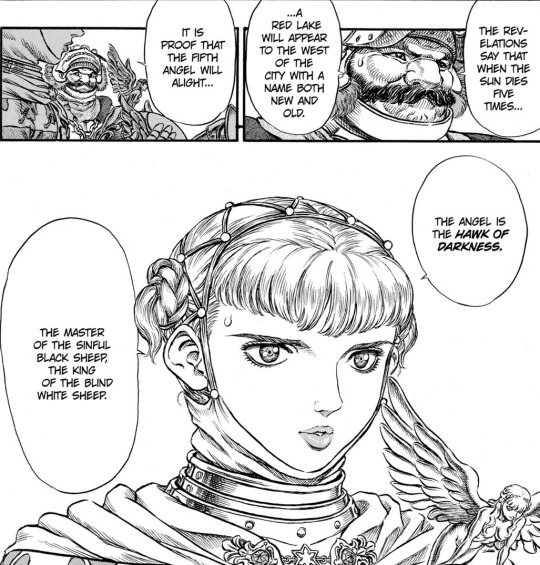


The fifth angel, the Hawk of Darkness, pretty obviously Femto. There’s no mystery here.
And honestly, the Age of Darkess is pretty explicitly discussed during the Conviction Arc. There’s really no mystery there either, at least not yet.
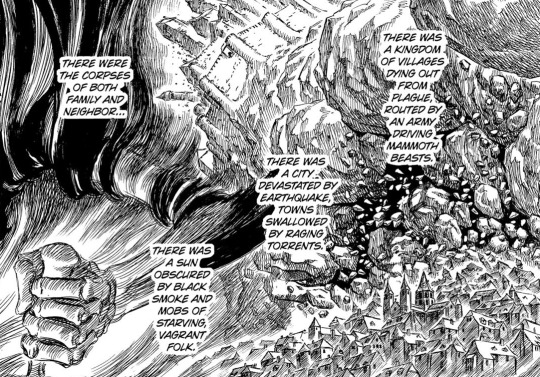
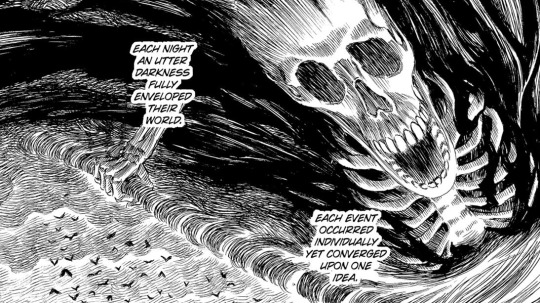


(I’m relatively certain that last line is essentially identical to “they sensed intuitively” from NGriff’s resurrection, and which I’ve also seen translated as “knew,” and so I wouldn’t put too much stock in the word “believed” there as purposefully leaving room for doubt, just fyi.)
Like, this is hammered in over and over. This prophetic dream of plague and natural disasters and war and famine, followed by Laban bemoaning the state of the world as these events come true and he encounters a landslide and a village full of plague, and we see tens of thousands of starving refugees outside the Tower of Conviction, and Kushan war elephans make an early appearance, etc.

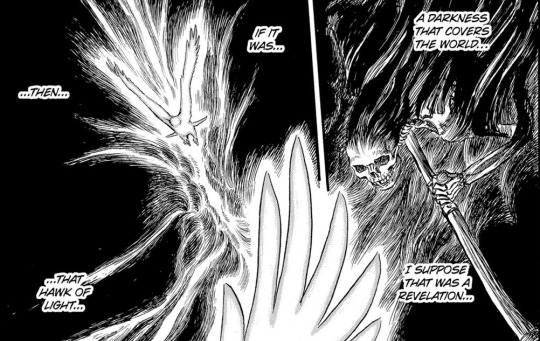
Dark shadow, darkness that covers the world, thick darkness, utter darkness, etc etc. It’s not subtle, and it’s pretty clearly the intended follow-through to Slan’s words and Farnese’s prophecy. The Conviction Arc shows us the world that’s shitty enough to motivate humanity to will a saviour into being.
Also while Age of Darkness sounds a little too impressive to be boiled down to a measley 2 years that suck extra hard, I’d argue that this is more like the straw that breaks the camel’s back. Plague and famine etc just draw into sharp relief the divide between the have and the have-nots, which is largely what the Conviction Arc is about. It’s about nobility terrorizing peasants through the Inquisition, and neglecting peasants as Laban muses that the King is too obsessed with trying to find Griffith to allocate resources to relief efforts, and how much this fucks the world up.
The Conviction Arc shows us a pretty good example of a world where darkness, ie wickedness, hatred, hostility, the dead, and illusion (I’d argue Mozgus’ brand of religion, especially with how much fun the narrative has with painting it as super fucked up and hypocritical etc, like God’s love being a torture chamber, fits that bill) covers the light.
And it’s the kind of world that Femto requires in order to be incarnated physically.
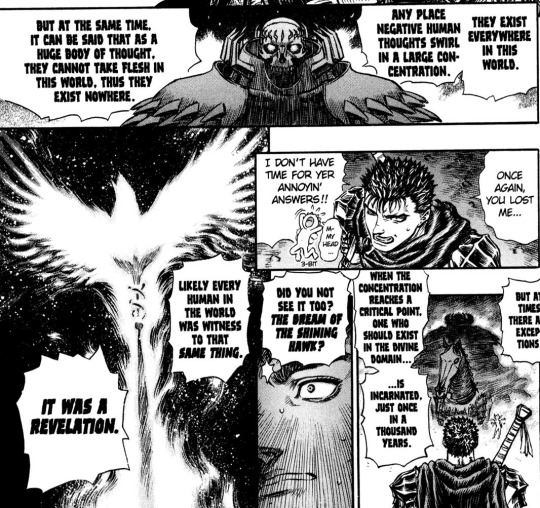
So whether the “Hawk of Darkness,” directly caused this “Age of Darkness,” or whether it’s more like, yk, humanity/fate caused it itself because humanity’s negative emotions reaching a critical point allows him to incarnate and change shit up as per humanity’s desires (this is all there in the Lost Chapter), I’d stay it fits the prophecy. Femto = Hawk of Darkness = Age of Darkness = all the darkness of humanity emphasized.
But this gets muddy once NGriff does show up and we get the sequence where his apostle captains meet him etc:
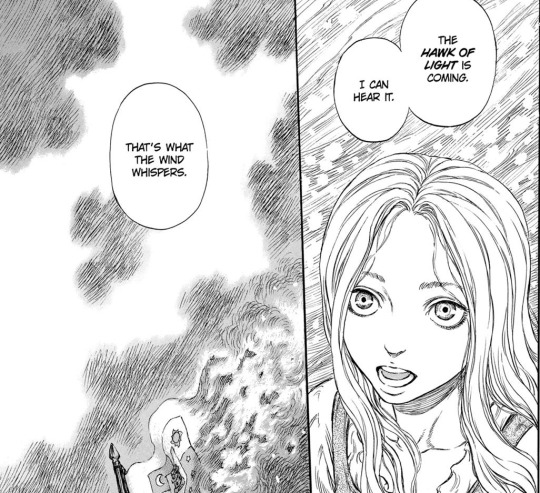



Like okay, so Schierke’s maybe just reciting the old prophecy, since it’s the exact same wording Farnese gave us, so maybe this doesn’t change what we were lead to believe was the Age of Darkness? I mean at this point we’d be still in the midst of it, going by what was stated in the Conviction Arc. The future tense could just be because it’s an old prophecy.
But the future tense is there (and I double checked with a scanlation lol, and it was there in that translation too, so I’m assuming it’s part of the original Japanese wording), and it’s worth considering that this is still meant to be foreshadowing and the Age of Darkness is yet to come. In which case it would presumably be Fantasia.
So one possibility is that the Conviction Arc is either a giant Age of Darkness red herring or it has been retconned out of being the Age of Darkness, and we’re meant to understand Fantasia as the prophecized Age of Darkness brought down by the Hawk of Darkness.
I’m not fully on board with this possibility because a) the Conviction Arc was pretty damn straightforward and made perfect sense as the AoD and I hate retcons, and b) Fantasia is defined by light lol, not darkness. Both literally in that a bright white light envelops the Earth as it changes and it’s often described in terms of light, and figuratively in that I’d suggest every one of Slan’s examples of light up there (love, hope, etc) is illustrated in the nature of Fantasia. Humanity joining together despite differences including apostles, hope, astral planes merging (which I’d argue makes the world more real, not less), the living (NGriff’s funeral services make people more at peace with the idea of death and able to emotionally recover from the loss of loved ones much easier), and I’d also argue that this chill easy going accepting version of organized religion we’ve seen fits the ‘sacred’ bill a lot better than Mozgus’ horrific version.
Admittedly you can argue the opposite for some of these points, like maybe Griffith’s funeral services making people more cool about death is a bad thing and an example of death eclipsing life. Maybe the astral plane is supposed to be more illusion than reality. Maybe we’re eventually going to see hostility and hatred in the world outside Falconia. Hell, maybe the Sea God slog was meant to be indicative of the ~darkness~ (and to be fair I did not re-read much of the sequence to try to find examples of the narrative evoking darkness as a description, so it could be there. But it’s gonna take more than an anon ask to get me to re-read the entire Sea Sea god subplot lol.) But even from Guts’ perspective the joining of the astral plane also includes wholesome Elfhelm-y shit, so it’s still not as simple as evil sea gods and monsters now getting to fuck shit up, we also get helpful mermaids and stuff.
So yeah so far given what we know, the pre-Fantasia world fits the description of the Age of Darkness perfectly and really heavy-handedly lol, with all the references to darkness involved, and Fantasia is a lot less clear-cut.
So the way I’d interpret this prophecy is that Griffith is both the Hawk of Darkness and the Hawk of Light, which imo is likely to be in part an on the nose reference to Femto as his inner darkness vs NGriff who does, in fact, save the world in a way characterized by light lol.
And which one you see him as depends on your point of view. It’s not that Sonia is wrong and being tricked and Schierke is right and sees the truth. It’s that Sonia, living in the Age of Darkness, losing her parents and almost being enslaved etc, and being saved by Griffith, is in a position to see Griffith as a saviour, along with most of the rest of humanity, which was collectively crying out for a change that Griffith’s dream and goals in particular are suited to enacting.
Schierke, distanced from humanity, not actually in danger of being burnt at the stake or starving to death or whatever, and more knowledgeable about the astral plane, sees Griffith as the Femto-y Hawk of Darkness, king of the blind white sheep (his human followers, one presumes), master of the sinful black sheep (apostles one also presumes).
And the fact that this chapter doesn’t end on Schierke’s assessment but on Sonia looking on at Griffith in awe, followed by yk 150 odd chapters of NeoGriffith being portrayed as the protagonist of his half of the story rather than the antagonist of Guts’, followed by seeing those “sinful black sheep” and “blind white sheep” up close as interesting and likeable characters in their own right who go out of their way to help people (Sonia rescuing Kushan children, later apostles helping humanity, eg), make friends with some of Guts’ rpg group including Schierke, at one point join Guts and co in a fight against a greater enemy while being directly paralleled to Guts (Zodd), etc suggests that maybe that particularly harsh description is not fully accurate or fair.
If Fantasia does turn out to be the (an?) Age of Darkness after all, I imagine that would also be depicted as a more dual thing depending on your perspective. For those getting eaten by dragons, yk, maybe Age of Darkness is a fair description. For those living in peace, maybe it’s not.
Also as an aside, to address a counterpoint I just came up with lol, I don’t think the relative tininess of Falconia vs the rest of the world has much bearing on this. Miura’s Berserk is pretty solely focused on this one particular chunk of the world, and there’s virtually no acknowledgement that Midland and the surrounding area is actually just a tiny microcosm of the world. I mean, the Godhand and the Idea of Evil are presumably not solely the manifestations of fantasy Europeans’ negative subconsciousnesses, but it’s their suffering and their inequal society that allows Griffith to manifest physically. No acknowledgement as to whether like, the wildly different societies throughout the world, some of which are probably more equal and less hit by plague and famine, and therefore more content, should counterbalance all the suffering in Midland and area lol.
To me this feels like a pretty typical issue/trope with medieval fantasy that Miura’s just kind of casually playing into bc he doesn’t particularly care about subverting it or making a point about it so much as he cares about using this established structure to tell his own story. Even during the Fantasia montage, we only saw medieval pseudo-Europe. The lone acknowledgement that the world is technically bigger than a stretch of land between Midland and fantasy India (+ Elfhelm) was the page of the bright light spreading across the Earth as seen from space. And like, a secretive conversation between 2 of Guts’ current allies (Magnifico and Roderick) discussing the possibility of colonialism lol.
Again, maybe we’ll see acknowledgement in the future? Maybe eventually the narrative will come out and say that yeah, it’s absolutely absurd to think that a happy kingdom whose residents number in the thousands is a beacon of hope for 99.99% of the world that has no way to get to it lol and is presumably, in theory, stuck with their own dragons and stuff now. Maybe Berserk will ultimately turn out to be a giant thoughtful subversion of European-esque fantasy stories that treat Europe as the centre of the world. But based on what we’ve seen so far I don’t think there’s much reason to assume that lol.
Like even the Elfhelm warlocks don’t point that out when they had the perfect chance to, they just say that it sucks that Griffith made his kingdom the only peaceful place, forcing people to choose between Fantasia and Falconia. They don’t say that the vast majority of the world doesn’t even get access to that choice lol, and so I don’t think it’s meant to be relevant.
I also want to point out that Miura redacted the Lost Chapter because it gave too much away too soon, and has since spent some time hinting about things those of us who’ve already read it probably know.
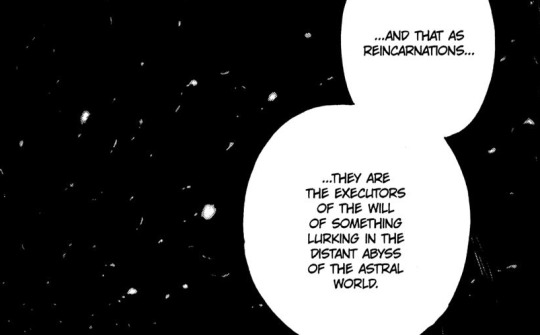
Like Flora doesn’t know what that something lurking in the abyss is, but we do, and it’s humanity’s dark, painful subconscious itself.
Griffith is essentially the avatar of humanity, hence why he’s humanity’s “desired,” and is remaking the world in humanity’s collective image. And like humanity isn’t all good or all evil but contains both, so does NeoGriffith, imo. Even the “Idea of Evil” isn’t evil itself, it simply fulfills a role humanity desires - the role of villain, essentially. It’s the reason why bad things happen, it’s the scapegoat for humanity.
The Hawk of Darkness is symbolic of the darkness of humanity - and that’s pretty much the point of Femto, I mean just check Slan’s heavy-handed Eclipse commentary of “this is what it means to be evil. This is what it means to be human” - and the Hawk of Light is symbolic of at least the potential humanity has to overcome that darkness, imo.
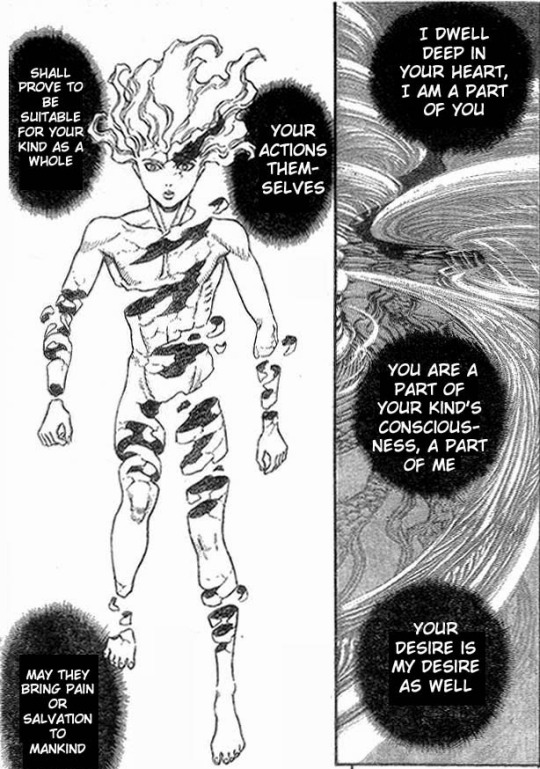
I’ve always puzzled over pain vs salvation there, and I still do, but hey one possibility is that it’s a suggestion that humanity’s over the Idea of Evil being the scapegoat that brings them pain (fate making bad things happen basically, so humanity has something to blame), and wants it to bring them salvation instead - light. And through NGriff’s transformation of the world, humanity reaches that light themselves by uniting in peace to survive against their own demons. Even outside of Falconia, humans are only going to be able to live in a world full of fantasy monsters by uniting together lol.
And like until I’m conclusively proven wrong I’m going to maintain that
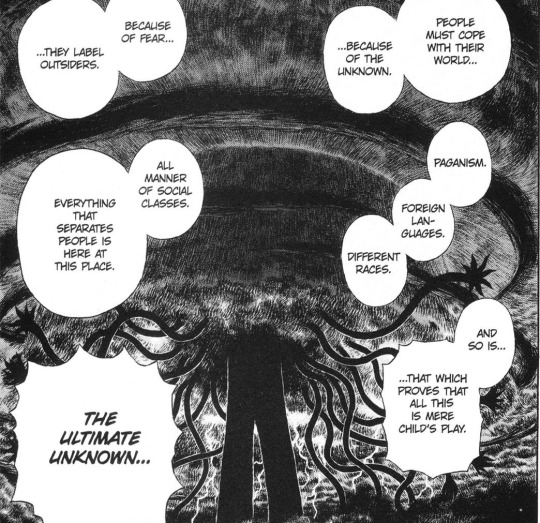
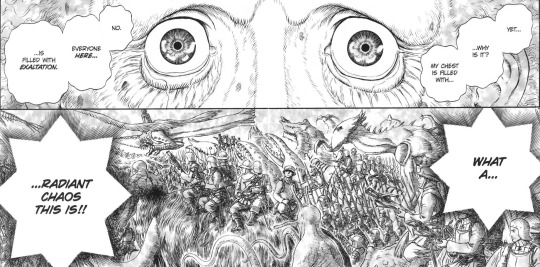
Fantasia being defined through joining humanity together is pretty solidly framed as a positive thing. Maybe humanity working together in peace is light and salvation, love over hate, hope over hostility, reality over illusion (the ultimately meaningless differences that divided people), etc.
SO I guess at the end of the day what I think is that Griffith is simultaneously the Hawk of Darkness and the Hawk of Light, that while Fantasia has some downsides to say the least lol we’re not necessarily supposed to take Elfhelm Warlock dudes’ assessment as the be all end all either. We’re getting 2 sides to this utopia story and we’re probably meant to judge for ourselves whether it seems worth it or not. Schierke would say no and prioritize the darkness of Griffith, ie the Hawk of Darkness, Sonia would say yes and prioritize the light, the Hawk of Light, and neither are wrong. But idk, maybe both might be able to grow from seeing the other’s point of view and incorporating it into their own understanding of the world.

I’m also thinking this dark vs light stuff is going to come into play in a big way when Guts and Griffith confront each other, and I imagine that their relationship is actually going to get the final say in all this. Hate or love, hostility or hope, illusion or reality, the dead or the living, wickedness or sacredness. Does this not to a tee describe them post Eclipse vs pre Eclipse?
Maybe if the Age of Darkness is still to come afterwards, they’ll end up plunging the world back to its original status quo when they conflict and kill each other or whatever, and take Falconia/the world tree/whatever down with them. Maybe NGriff’s unfrozen heart will come into play as the final piece of the thematic puzzle if the Hawk of Light represents the light of humanity, which ofc includes love. Maybe all it will take to conclude the themes in a satisfying way is a moment of understanding of that “true light” between them, discovered in darkness, while they fight.
Like you’ll pry my reading of Berserk’s themes as consistently and thoroughly existing to symbolize Griffith and Guts’ relationship out of my cold dead hands lol.
Fuck sorry this got so long and meandering. What did I say about trying to keep my thoughts organized lol?
Anyway tl;dr I don’t know shit and I don’t think the world of Berserk actually makes much sense, but let me throw out some theories and interpretations of possible contradictions and weird ass world building lol. And I mean, Miura is pretty consistent in interviews about saying Berserk isn’t about plain old good vs evil, so it wouldn’t surprise me at all to get something more complex and interesting than “Griffith is the evil Hawk of Darkness tricking humanity into seeing him as the Hawk of Light, and Guts is going to save the world from him.”
OH SHIT AND I ALMOST FORGOT: I have no idea where Schierke calls Griffith “false,” so you’ll have to point that part out to me, unless it’s just a difference in translations or something. Sorry I can’t address that part, hopefully you’ll at least scroll to the end and see this even if it’s super tl;dr lol.
#Anonymous#ask#a#berserk meta#b#lost chapter spoilers#theme: fate#character: neogriffith#theme: true light#theme: morality#berserk is a lot of things but it's not overly simplistic i'll give it that#theme: spirit world
25 notes
·
View notes